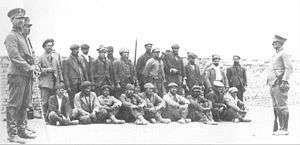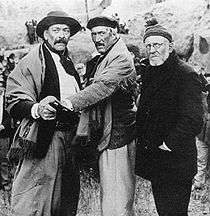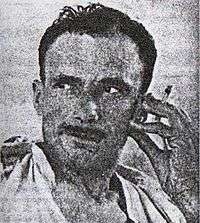Patagonia Rebelde
Patagonia Rebelde (or Patagonia Trágica) ("Rebel Patagonia" or "Tragic Patagonia" in English) was the name given to the uprising and violent suppression of a rural workers' strike in the Argentine province of Santa Cruz in Patagonia between 1920 and 1922. The uprising was put down by Colonel Héctor Benigno Varela's 10th Cavalry Regiment of the Argentine Army under the orders of President Hipólito Yrigoyen.[2] Approximately 300[3]-1,500 rural workers were shot and killed by the 10th Cavalry Regiment in the course of the operations, many of them executed by firing squads after surrendering. Most of the executed were Spanish and Chilean workers who had sought refuge in Argentina's Patagonia after their violent strike in the city of Puerto Natales in southern Chile on 27 July 1920 was crushed by the Chilean authorities, at the cost of four carabineers killed.[4] At least two Argentine soldiers (Privates Fernando Pablo Fischer and Domingo Montenegro), three local policemen (sergeant Tomás Rosa and constables Ernesto Bozán and Juan Campos) and a number of ranch owners and their relatives also died during the strife. Several of the captured women were raped in the uprising as the rebel forces fought for control of the territory.[5][6] The most detailed narrative of these events is that by Osvaldo Bayer (1972, below), summarized in English by Bruce Chatwin in 1976.[7]
 Arrested workers after the strike's suppression | |
| Date | 1920-1922 |
|---|---|
| Location | Santa Cruz Province, Argentina |
| Also known as | Patagonia Trágica |
| Participants | Argentine Army Anarchist strikers Patriotic League |
| Deaths | 300[1]-1,500 |
First strike

In 1920, in the aftermath of the First World War, the price of wool had dropped significantly provoking an economic crisis in sheep-breeding Argentine Patagonia.[8] In August 1920 there were a number of strikes in the province of Santa Cruz, followed by a general strike declared on 1 November. Most of the strikers were shearers and rural workers. The first armed confrontation took place on 2 January 1921 near El Cerrito, where four policemen and a striker were killed, and two policemen and a gendarme were taken hostages. Another gendarme was shot and killed in an ambush at Centinela river several days later. The ranchers and the interim governor Edelmiro Correa Falcón, himself a landowner, used the incidents to ask the federal government to declare the state of emergency in Santa Cruz. As the unrest spread, the government of Hipólito Yrigoyen ordered Colonel Héctor Benigno Varela's 10th Cavalry Regiment immediately to the affected area and the Argentine Navy seized the various ports and key facilities in the province. The new police chief in Santa Cruz, Oscar Schweizer, under orders of the new governor of the province, radical Ángel Ignacio Yza, instructed Varela to avoid bloodshed and the army colonel was able to work out a deal with the strikers and the ranch owners, and prohibited the payment of wages in Chilean money. In May 1921 the cavalry regiment returned to Buenos Aires but their leave was cancelled in October as strikes broke out again in the province when the ranch owners reneged on their promise of fairer working conditions. The leader of the strikers was a Galician anarchist, Antonio Soto, general secretary of the Workers Society of Río Gallegos, the local branch of the Argentine Regional Workers' Federation. Manuel Carlés, president of the Argentine Patriotic League is reported to have violently broken up one of the demonstration of the strikers in Río Gallegos with one dead and four injured in the resulting meleé. The month of August saw activity in the ports of Deseado, Santa Cruz, San Julián and Río Gallegos come to a complete standstill with a general strike. Hundreds of strikers believed to be anarchists or Bolsheviks were either thrown in jails or shipped back to Buenos Aires. The Buenos Aires press referred to the armed strikers as "anarchists" and "thieves". At the same time, the Chilean government grew alarmed at the prospect of facing similar unrest in southern Chile and deployed a strong carabineer force under colonel Carlos Ibáñez del Campo to the city of Puerto Natales. According to historian Miguel Angel Scenna, the Argentine government soon grew suspicious of the deployment of this Chilean force on the Chilean-Argentine border. According to captain Elbio Carlos Anaya, a company commander in the 10th Cavalry Regiment, the Chilean carabineers guarding the mountain passes, let the strikers to cross back and forth into Argentina armed with weapons and without any hindrance on the part of the authorities.[9] On 16 November 1921, however, the Chilean government eventually took sides and allowed colonel Varela and a motorized column of 13 soldiers to take a 50 km shortcut from Rio Turbio to Cancha Carrera through Chilean territory, east of Puerto Natales, along today's Highway 9.[10][11]
Second strike and repression

Colonel Héctor Benigno Varela's 10th Cavalry Regiment was ordered to return to Santa Cruz Province in November. His company commanders in the second expedition were captains Pedro Viñas Ibarra and Pedro E. Camposare. A detachment of National Gendarmerie troops was also added to the cavalry force. This unit sailed for Santa Cruz on 4 November 1921. In the meantime as a group of ten strikers approached the Estancia Bremen, the German ranch owner and his parents sensing danger, sought to defend their property with carbines and two strikers were killed and four were wounded in the exchange of fire. In response the strikers took several ranch owners and their families hostage and reportedly killed and raped some. Upon disembarking at Santa Cruz port the 10th Cavalry Regiment soon made its presence felt with arbitrary arrests and executions. After a clash in Punta Alta the 10th Cavalry Regiment liberated 14 hostages. But the soldiers were also reported to have killed some 100 unarmed workers suspected of collaborating with the strikers, among them Santiago González, a stonemason at the local Argentina National Bank (Banco de la Nación Argentina) branch. González, an anarchist, was forced to dig his own grave before being shot. Albino Argüelles, secretary general of the Sociedad Obrera of San Julián, a blacksmith and a member of the Socialist Party, was also captured and shot in November 1921. In December one of the ranch owners, Daniel Ramírez, was himself taken into detention under the orders of captain Anaya for assisting and actively cooperating with the armed strikers. Ramírez was executed in the first week of February 1922 after having been brutally tortured for over a week. His wife and several local merchants intervened and pleaded for his life, but this was to no avail. At Paso Ibáñez a large column of some 900 demoralised armed strikers tried to negotiate a favourable surrender with Colonel Varela but were soon rebuffed and retreated to regroup at Río Chico and Estancia Bella Vista after freeing those they had taken captive as hostages. In the meantime the local police forces hunted down and arrested or executed those sympathetic to the armed uprising. The cavalry regiment captured some 480 strikers in the interior at Cañadón León along with 4,000 horses and 298 rifles and carbines and 49 revolvers.[12] More than half of those captured at Cañadón León were executed before the firing squads stopped. The regiment then stormed La Anita and Menéndez Behety estancias and some 80 ranch owners and their families as well as captured policemen and other civilians are released in the operation and around 500 captured strikers executed. The armed strikers, knowing there would be no mercy, made a desperate last stand at Tehuelches train station but were defeated after a one-hour long battle and the survivors marched off to firing squads. At Estación Tehuelches (today's Pico Truncado) the army lost the only soldier killed in action during the campaign, Private Fernando Pablo Fischer.[13] The other soldier to die in the operations was another conscript, 19-year-old Domingo Montenegro from the Clase 900 (1900 intake of conscripts), shot and killed in error in the darkness by Private Eusebio Peralta while Montengro returned to his vivac from sentry duties, according to historian Osvaldo Bayer who referred to the conscripts disparagingly as "poor rifle slavemen".[14]
The 10th Cavalry Regiment having accomplished its mission of putting the uprising soon received orders to return to Buenos Aires, but some 200 soldiers were left behind under the commands of captains Anaya and Viñas Ibarra. Contrary to Argentine popular myth, Varela received a frosty reception in Buenos Aires where the Minister of War gave him a complete dressing down. Varela also came under heavy criticism by the Socialist parliamentarian Antonio Di Tomaso.
Aftermath

News of the mass execution soon reached Buenos Aires but the government made no call into an official investigation for fear of political repercussions. Argentine socialists and anarchists however promised vengeance. Kurt Gustav Wilckens, a 35-year-old German immigrant from Silesia, had been deported from the United States for his radical political views. In Argentina, he worked as a stevedore at Ingeniero White and Bahía Blanca, as a farm worker in Alto Valle del Río Negro and as a correspondent for the anarchist newspapers Alarm of Hamburg and The Syndicalist of Berlin. Although he claimed to be an adherent of Tolstoy's pacifism, Wilckens killed Varela in a gun and bomb attack outside the officer's recently acquired home at Humboldt-Santa Fe in January 1923 because of his desire "to wound through him the brazen idol of a criminal system". Upon hearing of the assassination, Argentine President Yrigoyen arranged that the house the colonel had been paying off be given to the widow of Varela as a gift, even though the couple had only recently committed to purchasing. Wilckens himself was killed in Villa Devoto prison while awaiting sentencing, by José Pérez Millán Temperley, a young man from an aristocratic family belonging to the Patriotic League. Pérez Millán had served in Patagonia. He was the gendarme taken hostage by the strikers after the gunbattle at El Cerrito, in 1921, and was also a distant relative of Varela.[15] News of Wilckens's death led to a general dock strike and the burning of streetcars, as well as arrests, injuries and deaths but achieved according to historian Otto Vargas "an incredible miracle in unifying the divided working class in Argentina".[16] Pérez Millán was found guilty of manslaughter and condemned to eight years in prison. He was however declared insane 14 months later and admitted to Las Mercedes mental hospital in Buenos Aires, where he was eventually shot and killed by another immate instigated by Russian anarchist Boris Wladimirovich.[17]
In June 1921, Argentine parliamentarians debated a proposed law giving the state the power to control unions, declare strikes illegal, and reimpose the ten-hour workday. This debate provoked popular condemnation in a demonstration supported on all sides, followed by a general strike and a declaration of state of emergency along the country.
See also
- Ranquil massacre
- Tragic Week (Argentina)
- La Patagonia rebelde (film)
- Federación Obrera Regional Argentina
- List of massacres in Argentina
- List of cases of police brutality in Argentina
- Osvaldo Bayer
Notes
- La Patagonia Rebelde
- San Martino de Dromi, María Laura (1986). Historia sindical argentina, 1853-1955. Ediciones Ciudad Argentina, p. 54. (in Spanish)
- Los medios anarquistas hablan de 1.500 muertos, la prensa oficial de 300. La Causa Argentina, Juan Archibaldo Lanús , p 393, Emecé Editores, 1988
- La revuelta obrera de Puerto Natales en 1919 – Un aporte a la historia de los trabajadores de la Patagonia (in Spanish)
- Violan mujeres e inauguran el caos en el que sumen a la lejana gobernación resistiéndose a mano armada a las fuerzas policiales. La Tragedia Patagónica: Historia de un Ensayo Anarquista", Orlando Mario Punzi, p. 95, Círculo Militar, 1991
- Muchos eran comandados por oficiales de carabineros chilenos disfrazados de paisanos y disponían de modernísimas armas entregadas por el país trasandino; todo ello matizado con saqueos, asesinatos, incendio de estancias y violaciones de mujeres. Los Fusilamientos de la Patagonia", Oscar Troncoso, p. 73, Centro Editor de América Latina, 1972
- 'The Anarchists of Patagonia' in The Times Literary Supplement 11 Dec. 1976, also in Chatwin's Anatomy of Restlessness: Uncollected Writings, ed. Jan Borm and Matthew Graves (Jonathan Cape, 1996.)
- Los Sucesos de la Patagonia, La Patagonia rebelde Archived 2011-10-27 at the Wayback Machine By Johana Farjat (in Spanish)
- Bayer, II: La Masacre, p. 123
- Bayer, II: La Masacre, p. 131
- Punzi, Orlando Mario (1991). La tragedía patagónica: historia de un ensayo anarquista. Círculo Militar, p. 79. (in Spanish)
- Convenio propuesto por los estancieros a sus obreros, La Patagonia rebelde Archived 2011-10-27 at the Wayback Machine By Johana Farjat (in Spanish)
- Bayer, II: La Masacre, p. 125
- Dia 23, hora 24: Mientras la tropa se encontraba entregada al descanso el vivac es sorprendido con la detonacion de un disparo producido por el revolver del soldado Peralta Eusebio, clase 900, quien al incorporarse para acudir a la guardia de prevencion a objeto de relevar el servicio, se le cayo este. El disparo habia ido a herir mortalmente en la cabeza al cabo conscripto de la misma clase de Montenegro Domingo. La Patagonia Rebelde Osvaldo Bayer
- Bayer, IV, El vindicador, pp. 295-296
- Vargas, Otto (1999). El Marxismo y la Revolución Argentina. Editorial Agora, p. 143 (in Spanish)
- Bayer, IV, El vindicador, pp. 303-317
Sources
Bibliografía
- La Patagonia trágica. José María Borrero. (1928) (in Spanish)
- La Patagonia rebelde (tomo I: Los bandoleros). Osvaldo Bayer, Editorial Galerna, Buenos Aires, (1972) (in Spanish)
- La Patagonia rebelde (tomo II: La masacre). Osvaldo Bayer, Editorial Galerna, Buenos Aires, (1972) (in Spanish)
- La Patagonia rebelde (tomo III: Humillados y ofendidos). Osvaldo Bayer, Editorial Galerna, Buenos Aires, (1974) (in Spanish)
- La Patagonia rebelde (tomo IV: El vindicador). Osvaldo Bayer, Editorial Booket, Buenos Aires, (1997) (in Spanish)
External links
- Bayern, Osvaldo (2009). La Patagonia rebelde. Talleres Gráficos F.U.R.I.A. (in Spanish)
- Bohoslavsky, Ernesto (2005). Interpretaciones derechistas de la «Patagonia Trágica» en Argentina, 1920-1974, Historia Política, UBA-UNICEN-UNLP-UNMdP-UNS-UNSAM (in Spanish)
- Cronodata: Timeline of events from 1920 to 1922 (in Spanish)
- 1921: Una historia de la Patagonia argentina. Colegio Secundario Provincial N° 21 "José Font"; Gobernador Gregores (Santa Cruz) (in Spanish)
- Sangrientas huelgas patagónicas, by Felipe Pigna. Diario Clarín, Buenos Aires, 12 August 2007 (in Spanish)